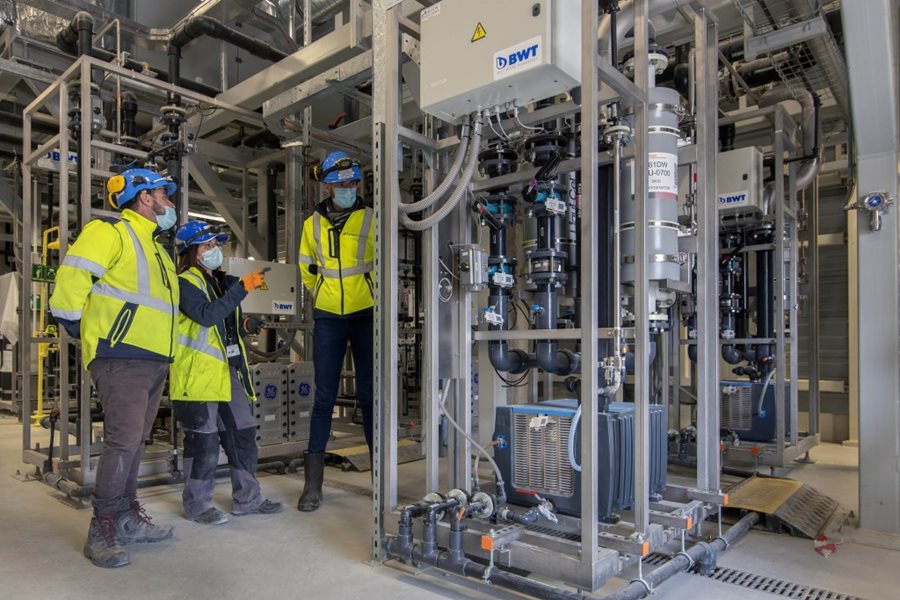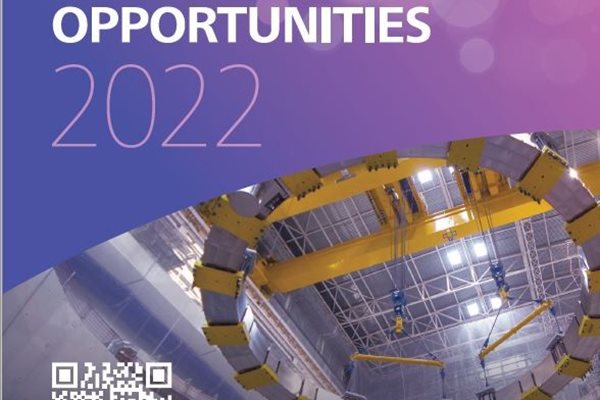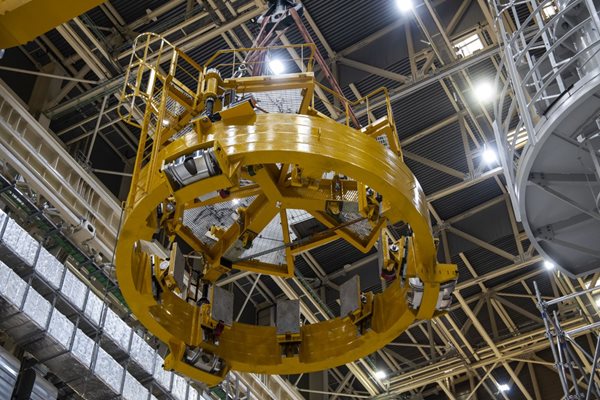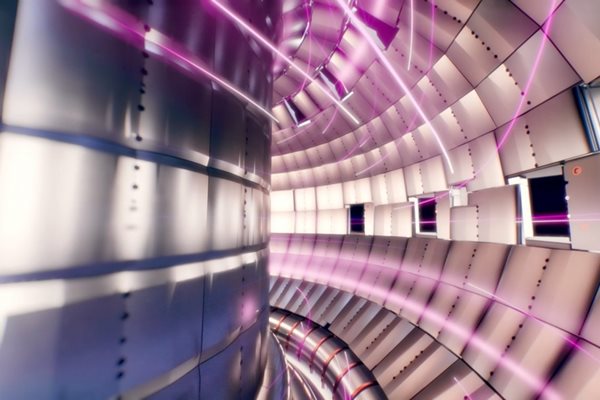
you're currently reading the news digest published from 14 Mar 2022 to 21 Mar 2022
featured3
of-interest1
press13
featured
Utilities | Directly from producer to consumer
When fully operational, ITER will be like a large living being with fluids rushing through kilometres of veins and arteries to organs located throughout the installation. By way of pumps, valves and compressors, powerful flows of air, water, helium and nitrogen will be pushed through a ramified network of underground pipes and delivered to a large variety of 'clients.' In early February, the first connection between producer and consumer was successfully established, delivering compressed air to the cryoplant's hundreds of pneumatic activators. The main utilities production facility at ITER is the 80-metre-long Site Services Building, located near the Tokamak Complex. Despite its unassuming name, the building will play a strategic role in the daily pulsing and throbbing of the ITER installation. Densely packed with a large variety of equipment—a demineralized water plant, chiller systems, air compressors, dozens of pumps and kilometres of piping—the facility will produce and distribute compressed and breathable air (for operators in ventilated nuclear suits), demineralized water for cooling circuits and detritiation systems, and cold water for air conditioning systems. Whether liquid of gaseous, the volumes produced will be considerable: the compressed air units for instance can deliver 5,000 cubic metres per hour at a pressure of 10 bar; the production capacity for demineralized water is approximately 34 cubic metres per hour. The facility hosts systems that produce, chemically treat and send compressed air and gases flowing to clients through the piping network. Hot water is produced in another unit hosting the largest electrical boiler in Europe. Gaseous helium for small consumers such as valves and local testing and inspection systems comes from bottle racks. Gaseous nitrogen extracted from the atmosphere by systems located in the cryoplant will be dedicated to the inerting of glove-boxes and other enclosures, valve actuation, ventilation for tritiated water holding tanks, and ventilation for cooling water system users like drying systems and nitrogen-based pressurizers and valves. Connecting the compressed air distribution network to the cryoplant was an essential step in the testing of the facility's 1,500 pneumatic actuators and hundreds of control valves. An integrated team composed of ITER operators and European staff from Fusion for Energy and Engage have been working closely together to achieve this milestone. The demineralized water system will be next, and progressively, one by one, all the clients throughout the installation on the platform will be served.
Recruitment | ITER to open new postdoctoral opportunities
Beginning April 2022, the ITER Organization will begin recruiting junior experimental or theoretical physicists and/or engineers for targeted projects. The new recruitment program is open to all post-doctorates from across the ITER Members. The ideal profile is a scientist, experimental physicist, or engineer who has completed a Ph.D. prior to the deadline for beginning the assignment, but not more than three years before the time of application. Specific opportunities will be advertised in the following project unit categories: Engineering Design Department Central Integration Office (mainly the Integrated Engineering Analysis Section) Science, Controls & Operation Department Plant Construction Department (Electrical Implementation Division) Machine Construction Department (Vacuum Delivery and Installation Section) The new postdoctoral opportunities are two-year positions. The program comes in addition to the Monaco-ITER postdoctoral fellowships that are offered at ITER every two years. 'One of the frustrations we've had in the past was having to select five candidates for the Monaco-ITER program every two years from among a large pool of superbly qualified candidates to work on a large range of interesting projects,' says Tim Luce, head of the Science and Operations Domain. 'This meant that, frequently, the ITER Organization could not recruit all the candidates required to address the highest priority projects from the Monaco postdoc program alone.' The new scheme aims at addressing this mismatch. 'We know there are highly trained professionals in the Members that can contribute real value by focusing on challenging short-term assignments in high priority research areas for ITER needs. We are also convinced that the time is right to attract the best and the brightest to fusion science and engineering and help increase the pools of trained specialists available to push R&D in the fusion devices of the future,' says Alberto Loarte, who leads the Science Division. A number of postdoctoral opportunities will also be offered in engineering design and diagnostics—a unique opportunity to offer young and talented engineers and researchers the opportunity to acquire the qualifications needed for a professional career in the field of fusion, according to Mario Merola, head of the ITER Engineering Design Department. 'There is often a gap between the knowledge obtained by students during their studies, and the experience and expertise that is needed to work effectively in leading-edge fusion technologies. The new ITER postdoctoral opportunity can be instrumental in covering that gap.' 'We see it as a win-win situation,' says Michael Walsh, head of the Port Plug & Diagnostics Division. 'We get to bring in early career professionals to work on our specific research needs, and in return we are helping to train the future leaders in our field. We are very excited to be able to offer these opportunities.' About 10 positions will be posted this year, beginning in April 2022; candidates can consult the openings on the ITER jobs webpage. New openings will also be advertised across all ITER social media channels. To promote the opportunity in your institute, download the poster here.
Image of the week | Designed for a strong embrace
Contrary to most components, the 110-tonne central solenoid modules cannot be equipped with lifting rings—drilling into the module is impossible and there is no space to place the attachments. As a consequence, US ITER has designed a unique tool that will clutch the module and secure it in its hold by exerting a strong radial force from the outside. Nine rectangular wedge pads located at the bottom of the 'lifting fixture' (five are clearly visible in this image) will each exert a force of 220 kN (kilonewtons) on the module as it is lifted and moved from the temporary table to the assembly platform. From November 2021 to January 2022, the teams practiced this delicate operation in the free space inside the Cryostat Workshop. Last week, the lifting fixture was moved to the Assembly Hall area dedicated to central solenoid activity. The installation of the first module on the assembly platform is scheduled during the last days of April.
of-interest
The Easiest Thing Nature Does (video)
The European Fusion Education Network FuseNet has released a new 30-minute video on fusion energy. In "The Easiest Thing Nature Does," the viewer is introduced to the whats, whys, and hows of fusion by some of the very people who are working on the ground in Europe to make fusion energy a reality. Meet researchers from CIEMAT (Spain), the Max Planck Institute for Fusion Energy (Germany), the ITER Organization, and York University (United Kingdom). Hear from members of the UKAEA/JET tokamak team, including a mechatronics engineer, a plasma spectroscopist, a senior operations manager, and a diagnostics project engineer. Learn about tokamaks, stellarators and the current dynamism of the private fusion sector. And drop by ITER, where construction is underway on the world's largest fusion device. It's an exciting time for those involved in fusion worldwide, and it's a sector that is recruiting. "The Easiest Thing Nature Does" lists the many types of skills that are needed and invites you to get involved! See the video on this FuseNet page or on YouTube.



